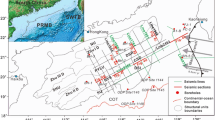Abstract
Dongsha Island and the adjacent sea area locate at the northern continental margin of the South China Sea (SCS), and is connected to the east by the Manila Trench. Analyses of seismic stratigraphy and gravity, magnetic and drilling wells data led to the discovery of three post-fault sequences (V, VI, VII). Extensive tectonic uplift, magma activity and erosion occurred in Dongsha Island and the adjacent area, where most of the faults in the northeastern SCS were still active during Pliocene and Quaternary. Two groups of faults trending NEE and NW were developed during Late Cenozoic. We conclude that three important tectonic movements, especially Dongsha movement (4.4–5.2 Ma) and Liuhua movement (1.4–1.89 Ma), controlled the structural framework in the Dongsha rise; whose deformation in the east is stronger than that in the west and whose stress field variation suggests that the tectonic uplift in the study area contributed to magmato-tectonic events correlated to the main collision phases between the East China and Taiwan 5-3 and 3-0 Ma ago.
Similar content being viewed by others
References
Briais, A., Patriat, P. 1995. Updated interpretation of magnetic anomalies and seafloor spreading stages in the South China Sea: Implications for the Tertiary tectonics of Southeast Asia.J. Geophys. Res. 98(B4): 6299–6328.
Chen, S., Hu, P., 1989. Tertiary reef complexes in the Zhujiangkou (Pearl River Mouth) basis and their significance for hydrocarbon exploration.China Earth Science 1(1): 21–29.
Chen, S. Z., Li, Z. S., 1992. Review and prospect of the oil and gas exploration in the eastern Zhujiangkou basin.Chinese offshore oil and gas (geology) 6(29): 21–30. (in Chinese)
Guong, Z., Jin, Q., Qin, Z. et al., 1989. Geology, tectonics and evolution of the Pearl River Mouth Basin. In: Zhu X. ed. Chinese Sedimentary Basin. Elsevier, 181–196.
Jin, Q. H., 1989. Geology and Oil and Gas Resource of the South China Sea. Geology Press, Beijing. (in Chinese)
Li, P. L., 1993. Cenozoic tectonic movements of the Zhujiangkou basin.Chinese offshore oil and gas (geology) 7 (6): 11–17. (in Chinese)
Li, P. L., Liang, H. X., 1994. The relation between the Cenozoic magma activity and the evolution and the oil-gas assemblage of the Zhujiangkou basin.Guangdong Geology 9(2): 23–34. (in Chinese)
Liu, C. S., Huang, I. L., Teng, L. S., 1997. Structures off southwestern Taiwan.Marine Geology 137: 305–319.
Liu, G. D. (ed), 1992. The geological and geophysical characteristics of the China sea and the adjacent areas. Science press, Beijing. (in Chinese)
Lüdmann, T., Wong, H. K., Wang, P. X., 2001. Plio-Quaternary sedimentation processes and neotectonics of the northern continental margin of the South China Sea.Marine Geology 172: 331–358.
Ru, K., Pigott, J. D., 1986. Episodic rifting and evolution in the South China Sea Basin.A. A. P. G. Bull 70(9): 1136–1155.
Shemenda, A. I., 1994. Subduction: Insight from Physical Modeling. Kluwer Academic Publishers, Dordrecht, 134–173.
Sibuet, J. C., Hsu, S. K., 1997. Geodynamics of the Taiwan arc-arc collision.Tectonophysics 274: 221–251.
Spanger-Nissen, S., Hayes, D. E., 1995. Gravity, heat flow, and seismic constraints on the processes of crust extension: northern margin of the South China Sea.J. Geophys. Res. 100 (B11): 22447–22483.
Tayor, B., Hayes, D. E., 1983. Origin and History of the South Chian Sea Basin.In: Hayes D E. ed, The Tectonics and Geological Evolution of the South China Sea and Islands, Part 2. Amer. Geophys. Union, Geophys. Monograph 27, 23–56.
Teng, L. S., 1990. Geotectonic evolution of Late Cenozoic arc-continent collision in Taiwan.Tectonophysics 183: 57–76.
Tyrrell, W. W., Christian, H. E., 1992. Exploration history of Liuhua 111 field Pearl River Mouth Basin, China.A. A. P. G. Bull. 76(8): 1209–1223.
Wu, S., Wong, H. K., Lüdmann, T., 1999. Gravity-driven sedimentation on the northwest continental slope in the South China Sea: results from high-resolution seismic data and piston cores.Chinese Journal of Oceanology and Limnology 17(2): 155–169.
Author information
Authors and Affiliations
Additional information
Financial support for this research was provided by the Ministry of Science and Technology Project (G200046704), Knowledge Innovation Project of the Institute of Oceanology of the Chinese Academy of Sciences, and the Fund of the Director of the Chinese Academy of Sciences (20010302).
Rights and permissions
About this article
Cite this article
Shiguo, W., Zhan, L., Wanyin, W. et al. Late cenozoic tectonic deformation in the Dongsha Islands and adjacent sea area. Chin. J. Ocean. Limnol. 21, 377–388 (2003). https://doi.org/10.1007/BF02860434
Received:
Accepted:
Published:
Issue Date:
DOI: https://doi.org/10.1007/BF02860434




